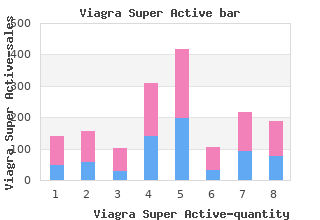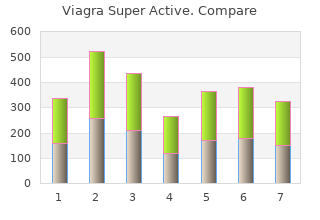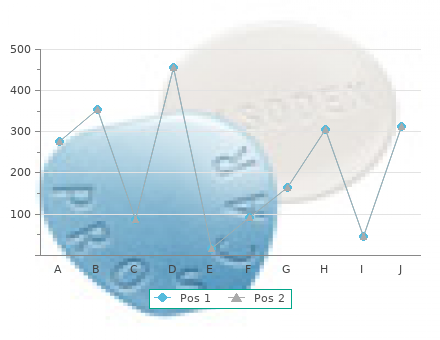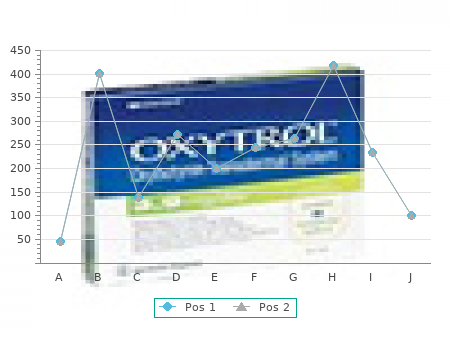Viagra Super Active
By O. Jaffar. Landmark College.
When the medial rectus muscle is paralyzed generic viagra super active 100 mg fast delivery impotence surgery, the eyes are exotropic (wall-eyed) on attempted lateral gaze toward the paralyzed side buy 25mg viagra super active with visa erectile dysfunction statistics worldwide, and the images are crossed. Cross References Cover tests; Esotropia; Heterotropia Extensor Posturing - see DECEREBRATE RIGIDITY External Malleolar Sign - see CHADDOCK’S SIGN - 113 - E External Ophthalmoplegia External Ophthalmoplegia - see OPHTHALMOPARESIS, OPHTHALMOPLEGIA Extinction Extinction is the failure to respond to a novel or meaningful sensory stimulus on one side when a homologous stimulus is given simultane- ously to the contralateral side (i. It is important to show that the patient responds appropriately to each hand being touched individually, but then neglects one side when both are touched simultaneously. More subtle defects may be tested using simultaneous bilateral heterologous (asymmetrical) stimuli, although it has been shown that some normal individuals may show extinction in this situation. A motor form of extinction has been postulated, manifesting as increased limb akinesia when the contralateral limb is used simultane- ously. The presence of extinction is one of the behavioral manifestations of neglect, and most usually follows nondominant (right) hemisphere lesions. There is evidence for physiological interhemispheric rivalry or competition in detecting stimuli from both hemifields, which may account for the emergence of extinction following brain injury. Neural conse- quences of competing stimuli in both visual hemifields: a physiologi- cal basis for visual extinction. Annals of Neurology 2000; 47: 440-446 Cross References Akinesia; Hemiakinesia; Neglect; Visual extinction Extrapyramidal Signs - see PARKINSONISM Eyelid Apraxia Eyelid apraxia is an inability to open the eyelids at will, although they may open spontaneously at other times (i. The term has been criticized on the grounds that this may not always be a true “apraxia,” in which case the term “levator inhibition” may be preferred since the open eyelid position is normally maintained by tonic activity of the levator palpebrae superioris. Clinically there is no visible contraction of orbicularis oculi, which distinguishes eyelid apraxia from blepharospasm (however, perhaps paradoxically, the majority of cases of eyelid apraxia occur in association with ble- pharospasm). Electrophysiological studies do in fact show abnormal muscle contraction in the pre-tarsal portion of orbicularis oculi, which - 114 - Eyelid Apraxia E has prompted the suggestion that “focal eyelid dystonia” may be a more appropriate term. Although the phenomenon may occur in isolation, associations have been reported with: Progressive supranuclear palsy (Steele-Richardson-Olszewski syn- drome) Parkinson’s disease Huntington’s disease Multiple system atrophy MPTP intoxication Motor neurone disease Acute phase of nondominant hemisphere cerebrovascular event Wilson’s disease Neuroacanthocytosis. The precise neuroanatomical substrate is unknown but the associ- ation with basal ganglia disorders points to involvement of this region. The underlying mechanisms may be heterogeneous, including involun- tary inhibition of levator palpebrae superioris. Neurology 1997; 48: 1491-1494 Cross References Apraxia; Blepharospasm; Dystonia - 115 - F “Face-Hand Test” - see “Arm Drop” Facial Paresis Facial paresis, or prosopoplegia, may result from: ● central (upper motor neurone) lesions ● peripheral (lower motor neurone; facial (VII) nerve) lesions ● neuromuscular junction transmission disorders ● primary disease of muscle (i. A dissocia- tion between volitional and emotional facial movements may also occur. Emotional facial palsy refers to the absence of emotional facial movement but with preserved volitional movements, as may be seen with frontal lobe (especially non- dominant hemisphere) precentral lesions (as in abulia, Fisher’s sign) and in medial temporal lobe epilepsy with con- tralateral mesial temporal sclerosis. Volitional paresis with- out emotional paresis may occur when corticobulbar fibers are interrupted (precentral gyrus, internal capsule, cerebral peduncle, upper pons). Causes of upper motor neurone facial paresis include: Unilateral: Hemisphere infarct (with hemiparesis) Lacunar infarct (facio-brachial weakness, +/− dysphasia) Space occupying lesions: intrinsic tumor, metastasis, abscess Bilateral: Motor neurone disease Diffuse cerebrovascular disease Pontine infarct (locked-in syndrome) ● Lower motor neurone facial weakness (peripheral origin): If this is due to facial (VII) nerve palsy, it results in ipsilateral weakness of frontalis (cf. Clinically this produces: Drooping of the side of the face with loss of the nasolabial fold - 116 - Facial Paresis F Widening of the palpebral fissure with failure of lid closure (lagophthalmos) Eversion of the lower lid (ectropion) with excessive tearing (epiphora) Inability to raise the eyebrow, close the eye, frown, blow out the cheek, show the teeth, laugh, and whistle +/− dribbling of saliva from the paretic side of the mouth Depression of the corneal reflex (efferent limb of reflex arc affected) Speech alterations: softening of labials (p, b). Depending on the precise location of the facial nerve injury, there may also be paralysis of the stapedius muscle in the middle ear, causing sounds to seem abnormally loud (especially low tones: hyperacusis), and impairment of taste sensation on the anterior two-thirds of the tongue if the chorda tympani is affected (ageusia, hypogeusia). Lesions within the facial canal distal to the meatal segment cause both hyperacusis and ageusia; lesions in the facial canal between the nerve to stapedius and the chorda tympani cause ageusia but no hyperacusis; lesions distal to the chorda tympani cause neither ageusia nor hypera- cusis (i. Lesions of the cerebellopontine angle cause ipsilateral hearing impairment and corneal reflex depres- sion (afferent limb of reflex arc affected) in addition to facial weak- ness. There is also a sensory branch to the posterior wall of the external auditory canal which may be affected resulting in local hypoesthesia (Hitselberg sign). Causes of lower motor neurone facial paresis include: Bell’s palsy: idiopathic lower motor neurone facial weakness, assumed to result from a viral neuritis Herpes zoster (Ramsey Hunt syndrome); Diabetes mellitus Lyme disease (borreliosis, Bannwarth’s disease) Sarcoidosis Leukemic infiltration, lymphoma HIV seroconversion Neoplastic compression (e. These latter conditions may need to be differentiated from Bell’s palsy. Causes of recurrent facial paresis of lower motor neurone type include: Diabetes mellitus Lyme disease (borreliosis, Bannwarth’s disease) Sarcoidosis Leukemia, lymphoma. In myasthenia gravis, a disorder of neuromuscular transmission at the neuromuscular junction, there may be concurrent ptosis, diplopia, bulbar palsy and limb weakness, and evidence of fatigable weakness.


If you’re nervous about working with a list of topics rather than a list of questions viagra super active 100 mg erectile dysfunction causes wiki, a good way to overcome this is to ask a few set questions first and then viagra super active 100 mg sale trimix erectile dysfunction treatment, once you and the interviewee have both relaxed, move on to a set of topics. With practice, you will feel comfortable interviewing and will choose the method which suits you best. If you take time to produce a detailed interview schedule, it helps you to focus your mind on your research topic, enabling you to think about all the areas which need to be covered. It should also alert you to any sensitive or con- troversial issues which could arise. When developing an interview schedule for any type of interview, begin with easy to answer, general questions which will help the in- terviewee feel at ease. HOW TO CONDUCT INTERVIEWS / 69 HOW TO DEVELOP AN INTERVIEW SCHEDULE X Brainstorm your research topic – write down every area you can think of without analysis or judgement. X Work through your list carefully, discarding irrele- vant topics and grouping similar suggestions. X Order these general topics into a logical sequence, leaving sensitive or controversial issues until the end – ask about experience and behaviour before asking about opinion and feelings. X Think of questions you will want to ask relating to each of these areas. If you’re new to research you might find it useful to include these questions on your schedule. However, you do not have to adhere rigidly to these during your interview. X When developing questions, make sure they are open rather than closed. X Become familiar with your schedule so that you do not have to keep referring to it during the interview. Don’t rush straight into the interview unless the interviewee pushes to do so. Accept a cup of tea, if offered, and make polite conversation to help put both of you at ease. X Think about your appearance and the expectations of the person you’re about to interview. If the interviewee is a smartly turned out business person who expects to be interviewed by a professional looking researcher, make sure you try to fulfil those expectations with your appearance and behaviour. Maintain appropriate eye-contact and smile in a natural, unforced manner. Remember that the eyes and smile account for more than 50% of the total communication in a greeting situation. If you es- tablish rapid and clear eye-contact, you’ll be more ea- sily trusted. X During the interview, firm eye contact with little move- ment indicates that you’re interested in what is being said. On the other hand, if your eyes wander all over the place and only briefly make contact with the eyes of the interviewee, low self-esteem, deceit or boredom HOW TO CONDUCT INTERVIEWS / 71 can be indicated. Conversely, watch the eyes of your interviewees which will tell you a lot about how the interview is progressing. Try not to sit directly opposite them – at an angle is better, but not by their side as you will have to keep turning your heads which will be un- comfortable in a long interview. By watching the eye movements and body language of the interviewees, and by listening to what they’re saying, you’ll soon know when you’ve established rapport. If, however, you notice the interviewees becoming uncomfortable in any way, respect their feelings and move on to a more general topic. Sometimes you might need to offer to turn off the recorder or stop taking notes if you touch upon a particularly sensitive issue. Negotiate a length of time for the interviews and stick to it, unless the interviewees are happy to continue. Make sure you thank them for their help and leave a contact number in case they wish to speak to you at a later date.


This substance buy 25mg viagra super active mastercard erectile dysfunction unani medicine, in 1921 purchase viagra super active 100 mg erectile dysfunction caverject injection, had been called a “bacteriophage” by D’Herelle, of Yale. Albee was able to show a phage appearing in 94% of 100 cases of acute and chronic osteomyelitis. His Lewis ANDERSON treatment was to clean the infected material out of the wound completely and then inject a bacteri- 1930–1997 ophage solution into osteomyelitic wounds. In 1933 Albee described a rather ingenious Lewis Anderson was born in Greensboro, arthroplasty of the elbow in which, after he had Alabama, on October 13, 1930. He attended reconstructed the joint, he lengthened the olecra- Emory University in Atlanta from 1947 through non with its triceps attached—in some ways a 1949 and received his MD degree from the Uni- comparable operation with his kinesiology lever versity of Pennsylvania in Philadelphia in 1953. Anderson served In 1934 he became greatly interested in low- as an intern at the Hospital of the University of back pain. Myofascitis, he said, was the principal Pennsylvania in 1953 and 1954 and then began a cause. This he described as a low-grade inflam- residency in general surgery at the same institu- matory change in the muscles and the fascia, with tion. His training was interrupted by 2 years of the fascial insertions of the muscle to bone active duty in the United States Naval Medical becoming hypersensitive because of toxic inflam- Corps, during which he served as the senior matory or metabolic changes. His treat- subsequently completed his residency at the ment for this condition was, first, the removal Hospital of the University of Pennsylvania. He emphasized colonic received his orthopedic training at the Campbell irrigation and the introduction of Bacillus aci- Clinic in Memphis from 1957 through 1960. Truly, he was an out- ate professor, and, from 1971 to 1977, as Profes- standing personality in the most progressive era sor of Orthopedic Surgery at the University of orthopedic surgery of all time. He once wrote, of Tennessee Center for Health Sciences in “I have never liked looking back. Although the bones did not heal faster with these techniques, he noted that immobility of adjacent joints, joint stiffness, malreduction, and nonunion—all well-known complications of 7 Who’s Who in Orthopedics closed treatment of fractures—often were American Academy of Orthopedic Surgeons, the avoided and that the overall rate of morbidity and American Orthopedic Association, the American complications was greatly reduced with early Medical Association, the Southern Medical Asso- motion, which could be used in conjunction with ciation, Alpha Omega Alpha, and numerous other rigid internal fixation. Anderson was an American– author of more than 60 articles that were pub- Canadian Exchange Traveling Fellow, along with lished in medical journals and of more than 20 Dr. III, demonstrated tremendous energy and good reported on his pioneering work in a paper enti- nature. He became a leader early in his career and tled “Compression-Plate Fixation in Acute was the model of a true “southern gentleman. Not only did this MD, died at the age of 67 in Mobile, Alabama, change in technology have a dramatic effect on after a brief illness. Anderson was asked to review all three editions of the Manual of Inter- nal Fixation, by the AO Group, for The Journal of Bone and Joint Surgery; the reviews appeared in 1971, 1980 and 1992. Anderson became the first Profes- sor and Chairman of the Department of Orthope- dic Surgery at the University of South Alabama in Mobile. In 1989, he was named the Louise Lenoir Locke Distinguished Professor of Ortho- pedics. He served as President of the Board of Directors of the University of South Alabama Health Sciences Foundation from 1979 through 1982 and again in 1985, as Secretary–Treasurer of the Medical Staff of the University of South Alabama Medical Center in 1979, and as Presi- dent of the Professional Medical Staff of the University of South Alabama from 1980 through 1982. In 1986, he was appointed Interim Dean of the University of South Alabama College of Med- Nicolas ANDRY icine. He was named Vice President for Medical Affairs at that institution in 1987 and retained that 1658–1742 position until 1992. Anderson was named Emeritus Professor of The “Orthos Pais” or great seal of the American Orthopedic Surgery at the University of South Orthopedic Association and the emblem of the Alabama. In 1996, he returned from retirement to crooked tree being straightened by a splint, used serve as Interim Chairman of the Department of by the British in their Presidential Badge of Office Orthopedic Surgery in order to provide continu- for the American Presidents at the London ity to the residency program that he had founded meeting in 1953, are tributes to Nicolas Andry, and that he loved. He also belonged to the little recognition, either for his broad view or for 8 Who’s Who in Orthopedics his conception of the details necessary for the and others of his time to attempt artificial proper care of the crippled child. Thus, he credited Andry and his genera- surgeon who is distinguished for having tion with many of the devices for shaping the fea- “patented” some catheters and urethral bougies tures, the waist and much of the body, dyeing the and for a text on diseases of the ureter.
Viagra Super Active
10 of 10 - Review by O. Jaffar
Votes: 141 votes
Total customer reviews: 141 |



